Types of Computer Cables: Everything You Need to Know
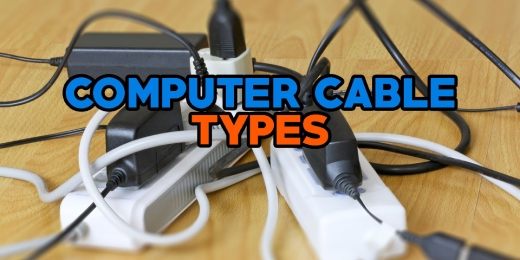
The cables of computers might not get all the attention, but they perform all the backstage chores behind the scenes. Each function of a device requires the right type of cable, from powering it to transferring data. The number of ports available is overwhelming. There are USBs, HDMIs, Ethernets, and DisplayPorts. Having a good understanding of your cables can save you time, improve performance, and even protect your gear. If you're setting up a gaming rig, a workstation, or even just connecting your printer, the right cable is essential. The mess needs to be untangled and broken down, cable by cable.
What are Computer Cables?
It may seem dull at first glance, but those tangled lifelines behind your desk are the lifeblood of your computer. Yet they are the glue that holds everything together. Computer setups can be compared to arteries. A monitor flashing crisp images or a keyboard swiping keystrokes wouldn't be possible without cables. The physical connectors serve as the bridge between devices, allowing data, power, audio, and video signals to pass through. It is the job of each cable to perform a specific task. There are some that are universal, such as USBs. What about others? SATA or DisplayPort are more niche.
Cables are only as valuable as their specificity. There are different types of cables for different devices, and mixing them up can cause frustration-or worse, damage to your equipment. Throughout history, cables have evolved. Rather than bulky VGAs and serial connectors, HDMIs and Thunderbolts are sleek and streamlined. Likewise, cables are becoming more sleek and faster as technology advances. By choosing the right one, you can increase speed, decrease lag, and even boost battery life. In other words, they're more than "wires." They're essential items. It's quiet, but it's very important.
Types of Computer Cables
HDMI Cable
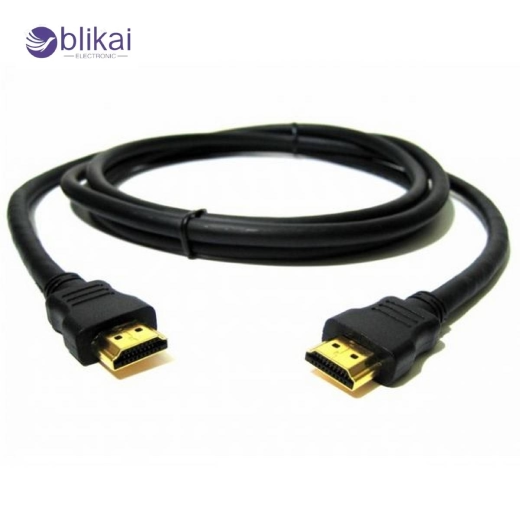
HDMI stands for High-Definition Multimedia Interface. There is nothing complicated about this cable, but it is a game-changer. As a result, the old mess of RCA, VGA, and DVI has been replaced. One cable. It includes both audio and video. There is no need for separate connections. Just plug in and go. Introduction in 2003 and quick adoption by the industry. What's the reason? Digital signals. Screens are clear, interference is nonexistent, and static is nonexistent. Movies, games, and presentations need only pure, sharp visuals. With the latest versions, you can even view content in 8K with resolutions ranging from 720p to 4K. There is no degradation of quality over distance as occurs with analog cables. Pixels remain perfect at all times.
It's not just about visuals when it comes to HDMI. There is also importance to sound. In addition to carrying audio, it also carries big audio. It supports surround sound setups including Dolby Atmos and DTS:X. You get a full cinematic experience with just one cable. In addition, it is constantly evolving. With HDMI 2.0, speeds of 18 Gbps were possible, sufficient for 4K at 60 frames per second. After that, HDMI 2.1 appeared. This is a monster. A bandwidth of 48 Gbps is available. The 4K at 120Hz and 8K at 60Hz options make it a favorite with gamers. VRR (Variable Refresh Rate), ALLM (Auto Low Latency Mode). As a result, there is no screen tearing or lag. There is a smoother look to movies. You feel like you are playing instantly. ARC and eARC are also available. There are fewer cables. There are only two wires, one for the TV and one for the soundbar. The HDMI standard simplifies everything.
Features
High-Speed Data Transfer
There are different types of HDMI cables. The bandwidth of earlier versions of HDMI, such as HDMI 1.4, was lower. The higher the resolution and refresh rate, the more difficult it was for them. HDMI 2.0 fixed this by offering 18 Gbps speeds, which is sufficient for 4K at 60Hz. After that, HDMI 2.1 was released. 48 Gbps. This is a huge leap. The display now supports uncompressed 8K video and ultra-smooth refresh rates. Lag-free and delay-free. Performance that is fast and seamless.
Advanced Audio Support
It's not just about visuals with HDMI. There is also a seriously good sound coming from it. We offer stereo, multi-channel surround sound, and everything in between. High-end formats like Dolby Atmos and DTS:X are supported. Do you want to experience cinema at its best? There's no need to worry about it with HDMI. The audio cable does not need to be separate.
HDR (High Dynamic Range) Support
Ever wondered what HDR-enabled TVs are like compared to regular TVs? There is a lot of color. There is more depth to the blacks. The whiter the color, the brighter it shines. This is made possible by HDR (High Dynamic Range). Multiple HDR formats are supported by HDMI, including HDR10, Dolby Vision, and HLG. Compared to standard video, it brings out more details.
ARC & eARC (Audio Return Channel)
The number of cables is reduced. That's what we're aiming for. ARC (Audio Return Channel) transmits audio back from the TV to the soundbar or receiver without requiring additional cables. Enhanced ARC (eARC) goes one step further. Provides support for high-bitrate audio formats, including Dolby Atmos and DTS:X. Audio connections are not required. HDMI is all you need.
Perfect for Gaming
Performance must be smooth and fast for gamers. A HDMI connection delivers. It eliminates screen tearing with features such as Variable Refresh Rate (VRR). With Auto Low Latency Mode (ALLM), input lag is reduced, making controls feel instantaneous. Is HDMI 2.1 available? For gamers who enjoy high-frame-rate games, this is a must-have. Is 4K at 120Hz possible? Yes. Gaming in 8K? It is possible. What is the PlayStation 5 and Xbox Series X? HDMI 2.1 is the best connection for them.
Ethernet Cable
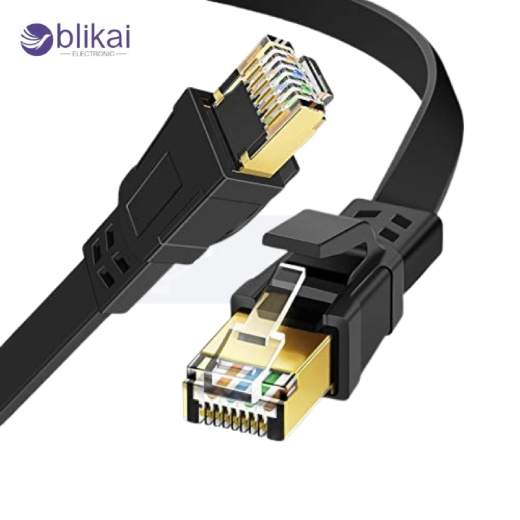
We are surrounded by wireless networks. The question is, what do you do when stability, speed, and security are needed? Ethernet wins. There are no dropped signals. There is no interference. The connection must be solid and reliable. The high-speed transfer of data through Ethernet cables ensures smooth, high-quality streaming in 4K, competitive gaming, or running a business network.
Ethernet cables connect devices to routers, switches, or modems directly. Signal congestion is not a problem with this type of connection, unlike wireless connections. The walls do not lag, and other networks do not interfere. Data pipelines are fast, secure, and efficient—physical pipelines for data. Networks run smoothly and efficiently thanks to Ethernet, which can be found in homes, offices, and data centers.
Features
High-Speed Data Transfer – Up to 40 Gbps
There has been a lot of progress in Ethernet. A 10 Mbps version was released first, followed by a 100 Mbps version. What about now? With modern Cat 6, Cat 7, and Cat 8 cables, gigabit and even multi-gigabit speeds are possible. Cat 6 can handle up to 10 Gbps over short distances. Cat 8? Quite the beast. With a bandwidth of 40 Gbps, it is suitable for data-heavy environments like gaming setups and servers.
Stable and Reliable Connection
There is fluctuation in Wi-Fi. Signals drop, speeds fluctuate, interference occurs. Ethernet? Solid as a rock. When you have a direct connection, you won't experience disconnects at random, lag spikes, or bandwidth dips. Stability is of the utmost importance to gamers, streamers, and professionals alike.
Low Latency – Instant Response Times
Have you ever experienced a delay while playing an online game? It's called latency. In some cases, Wi-Fi can add full seconds to the process. By using Ethernet, you can reduce lag. Often, ping times are less than one millisecond, so actions seem instantaneous. There is no such thing as a wasted millisecond in competitive gaming, video calls, or trading platforms.
Longer Cable Runs Without Signal Loss
When Wi-Fi is used over a long distance, it weakens. Ethernet? A more resilient system. There is no loss of speed when running a standard cable up to 100 meters (328 feet). Need more? Extending Ethernet with fiber optics or Ethernet extenders is another option.
Secure, Hacker-Resistant Connection
Hackers can take advantage of Wi-Fi. There is a possibility of intercepting signals. Ethernet? The breach is much more difficult. Due to the direct physical connection, data remains within the network, preventing unauthorized access. Wired networks are still widely used by banks, government agencies, and corporations.
RJ45 Connector – Universal and Easy to Use
RJ45 connectors are used for Ethernet cables, which work with routers, switches, computers, and gaming consoles. It's as simple as plugging in. You don't have to set up anything, pair anything, or worry about dropped signals. Reliable, simple, and universal.
Future-Proof and Compatible
The pace of technological advancement is rapid. However, Ethernet remains competitive. In years to come, Cat 6 and Cat 7 cables will still work. Due to Ethernet's backward compatibility, newer versions can be upgraded seamlessly. If old cables need to be swapped out, there is no need to replace everything.
5mm Audio Cable
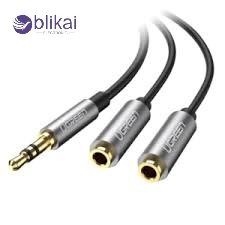
You've probably plugged in a pair of headphones before, right? What's that tiny round connector? It's a 3.5mm audio cable. Traditionally used for audio connections, it is also called an aux cable. Some old-school MP3 players, headphones, speakers, and even car stereos contain this component. Easy to understand. Suitable for everyone. A reliable source.
It's a changing world, though. There is a wireless revolution taking place. Headphone jacks are no longer found on many phones. Still, 3.5mm audio cables aren't going anywhere anytime soon. There's no substitute for wired audio for high-quality sound. It worked without a hitch. Lag-free. Batteries are not drained. The sound is crystal clear as soon as you plug it in.
Features
Universal Compatibility
Everywhere works with this cable. It can be a phone, a laptop, a speaker, a car audio system, or even a gaming controller. 3.5mm cables can be used with devices with a headphone jack. Software is not required. Drivers are not required. Audio is just a click away.
Stereo and Mono Support
There are different types of 3.5mm cables. A mono speaker (TS - Tip-Sleeve), on the other hand, is a speaker with a single channel of sound. Nowadays, most cables deliver left and right channel audio (TRS - Tip-Ring-Sleeve). Are you looking for even better performance? The TRRS cable (Tip-Ring-Ring-Sleeve) adds an extra ring to support the microphone, making it ideal for headset use.
Compact and Lightweight
Cables with 3.5mm connectors are tiny and easy to carry compared to bulky audio equipment. You can carry it in your pocket. Make sure you have one in your bag. Make sure you have a spare in your car. Streamlined, portable audio without heavy adapters or bulky accessories.
VGA Cable
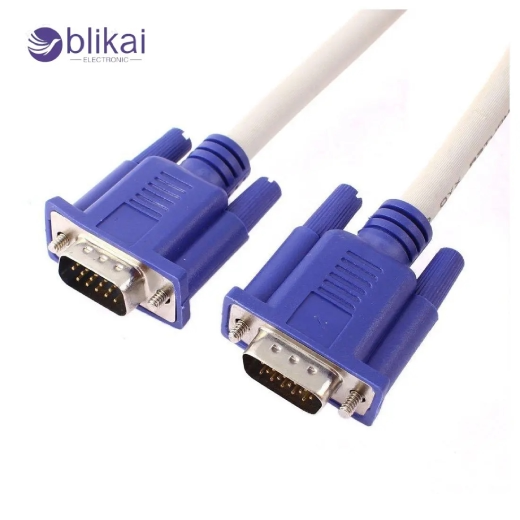
Video Graphics Array is referred to as VGA. This once-dominant display is now slowly fading from history. There is still a long way to go. Have you ever walked into an office? How about a school? Are you using an old, dusty desktop? Despite the fact that the show runs on VGA cables, you'll still find them here and there.
Since 1987, VGA has been the standard method of connecting computers to monitors, projectors, and televisions. HDMI and DisplayPort are digital, not analog. Because of this, long distances are more likely to result in signal loss. But what about back then? It was a revolution. There are still some older setups that use it.
Features
15-Pin Connector
An HDMI cable has 15 pins spaced in three rows. The plug is shaped like a trapezoid and is blue in color. Video signals are transmitted separately by each pin. Raw video data without audio or fancy extras.
Analog Signal Transmission
HDMI transmits digital signals, whereas VGA transmits analog signals. A long distance or a poorly shielded cable will result in deterioration of video quality. What about higher resolutions? Ghosting and blurriness are more prevalent.
No Audio Support
Video is the only thing that VGA can do. Sound is not present. The sound will be carried by a separate audio cable-like a 3.5mm aux cable-if you're using it. That's why HDMI eventually replaced VGA.
DVI cable
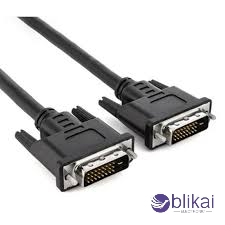
Digital Visual Interface is also known as DVI. Between VGA and HDMI, it is a bit of an awkward middle child. Compared to VGA, this is more advanced. HDMI is more sleek, but not as slim. The technology still exists in older monitors, projectors, and graphics cards.
As of 1999, DVI replaced VGA and transitioned displays from analog to digital. That's what happened during that time. After that, HDMI and DisplayPort took over. Is it possible to upgrade your graphics card and monitor if you have an old one? There is still a possibility that you will need DVI.
Features
Less Common Today, But Still Around
Most modern devices no longer support DVI due to HDMI and DisplayPort. However, it is still used by some old monitors, workstations, and gaming setups. It's not uncommon for GPUs to have a DVI port as a backup.
No Audio Support
The DVI connector carries only video, just like the VGA connector. There is no sound. Would you like audio? There will be a separate cable needed-usually an optical or aux cable.
Final Thoughts
There are several factors to consider when choosing computer cables. There are some that are obvious, such as USBs and HDMIs. What about others? That's not the case. Do you even know what Ethernet cables are supposed to do? VGA, for example, may be overlooked, but they are still important.
Cables can't just be grabbed and hoped for. Speed, power, and high-quality streaming are all factors to consider when choosing a GPU. When you don't use the right one, what will happen? There are problems with things breaking, connecting, or lagging. I'll tell you what's great about this: once you master it, it's really easy. There is no one-size-fits-all solution when it comes to cables. Each of them has a specific role to play. Choosing the right one ensures smooth operation. For each application, you need to know which cable to use.
Monitor Cables: Types, Applications & Advantages
Monitor Cable Types: A Complete Guide (2025)
Motherboard: The Core of Computer Hardware
Computer Hardware: Definition and Components (Guide)
What Are the Must-Have Computer Equipment for Home Offices?
How to Dispose of Capacitors?
Is a Fuse a Resistor? [Everything Explained]
Multimeter Not Reading Current [How to Fix]
Multimeter Not Reading DC Voltage: How to Fix it?
Temperature Coefficient of Resistance










